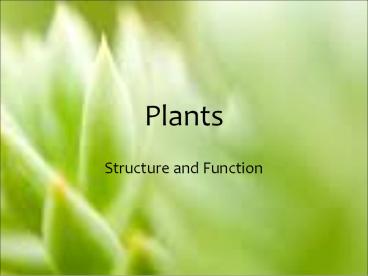Plants - PowerPoint PPT Presentation
Title:
Plants
Description:
Plants Structure and Function Plants An Overview Have existed on this planet for nearly 400 million years. Without plants, life on Earth would not exist as we ... – PowerPoint PPT presentation
Number of Views:338
Avg rating:3.0/5.0
Title: Plants
1
Plants
- Structure and Function
2
Plants An Overview
- Have existed on this planet for nearly 400
million years. - Without plants, life on Earth would not exist as
we know it. - Plants provide many great resources to planet
Earth, including sources of food, oxygen, and
habitat for other organisms. - Plants are known as producers, because they make
or produce their own food through the process of
photosynthesis .
3
Photosynthesis
- Photosynthesis is shown in the picture and
equation given below.
4
Photosynthesis continued
- Plants are autotrophic or autotrophs, which
literally means self-feeders. - A chemical equation is a written series of
symbols that contains both reactants
(ingredients) and products (end results). - Photosynthesis is a process that is unique to
plants and some protists without photosynthesis
there is no recycling of the oxygen and carbon
dioxide in the atmosphere.
5
Plant Structures and Functions
STRUCTURE FUNCTION
Roots Store nutrients absorb nutrients support plant
Stems Transport nutrients between leaves and roots
Leaves Primary site of photosynthesis
Seeds Plant embryos (undeveloped baby plants)
Chloroplasts Organelle where photosynthesis takes place
Chlorophyll Green pigment inside the chloroplasts that facilitates photosynthesis
6
Plant Structures and Functions
Nutrients Minerals and water that are absorbed by the plant through the ground or atmosphere
Flower Produces new plants by developing fruit that contains seeds this is the sexual organ of the plant
Stamen Male part of the flower contains the pollen (sperm cells)
Pistil Female part of the flower contains the eggs
Pollen Plant sperm cells male reproductive cell
Egg Female reproductive cell
Fruit Contains plant seeds used to attract other organisms to plants to help spread seeds
7
Plant Structures Roots, Stems, Leaves
8
Plant Structures The Plant Cell
9
Plant Structures The Flower
10
Seeds
- Seeds are undeveloped plants or in simple terms
baby plants. - All flowering plants produce seeds.
- There are two main types of seeds.
- Monocots which have one cotyledon.
- Dicots which have two cotyledons.
11
Seed Structures and Functions
STRUCTURE FUNCTION
Seed coat Protects seed from infection and dehydration
Cotyledon Provides energy and nutrients to begin growing
Plumule The part of seed that eventually grows into the first leaves
Hypocotyl The part of the seed that eventually grows into the stem
Hilum The area where the seed was attached to the ovary wall
12
Seed Diagram
13
Review Questions
- 1. Which observation of a plant supports the
inference that photosynthesis can take place?
- (1) a strong, sweet smell
- (2) a dry, rough texture
- (3) a green color
- (4) a smooth stem
14
Review Questions
- 2. A plant forms new tissue at the tips of its
roots and stems. This new tissue growth is a
direct result of
- (1) circulation
- (2) coordination
- (3) cellular respiration
- (4) cell division
15
Review Questions
- Which letter in the diagram represents the stored
food that the new plant will use for early
development? - (1)A (3)C
- (2)B (4)D
16
Review Questions
- 4. Several tomato plants are grown indoors next
to a sunny window. The plants receive water and
fertilizer and remain on the windowsill. What
will most likely happen?
- (1) Most of the leaves on the window side will
wilt and die. - (2) The roots of the plants will grow upward from
the soil. - (3) Water droplets will collect on the leaves
facing away from the window. - (4) The stem will bend toward the window.
17
Review Questions
- 5. What is the name of the process represented
in this diagram that produces the carbon dioxide? - (1) photosynthesis (3) respiration
- (2) metamorphosis (4) fertilization































